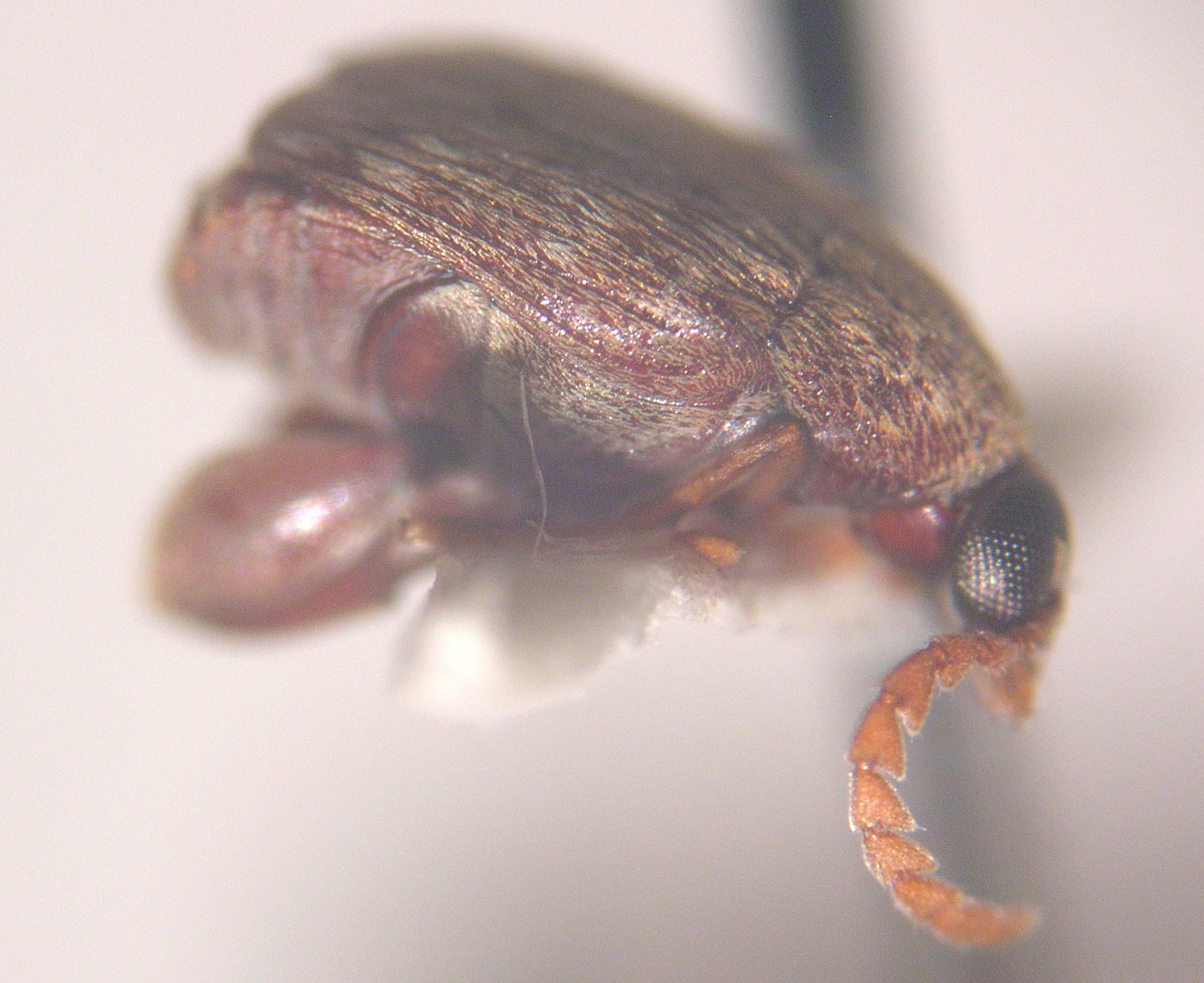- Bean weevil
Taxobox
name = Bean weevils

image_width = 250px
image_caption = "Acanthoscelides obtectus "
regnum =Animal ia
phylum =Arthropod a
classis =Insect a
ordo = Coleoptera
subordo =Polyphaga
infraordo =Cucujiformia
superfamilia =Chrysomeloidea
familia =Chrysomelidae
subfamilia = Bruchinae
subfamilia_authority = Latreille, 1802 [ITIS|ID=678800|taxon=Bruchinae]
diversity_link = Bruchinae
diversity = 58 genera
subdivision_ranks = Genera
subdivision = "About 1,350 species; see text."The bean weevils or seed beetles are a subfamily (Bruchinae) ofbeetle s, now placed in the familyChrysomelidae , though they have historically been treated as a separate family. They aregranivore s, and typically infest various kinds ofseed s orbean s, living for most of their lives inside a single seed. The family includes about 1,350 species found worldwide.Bean weevils are generally compact and oval in shape, with small heads somewhat bent under. Sizes range to 1 mm, up to 22 mm for some tropical species. Colors are usually black or brown, often with mottled patterns. Although their mandibles may be elongate, they do not have the long snouts characteristic of true
weevil s.Adults deposit eggs on seeds, then the larvae chew their way into the seed. When ready to
pupa te, the larvae typically cut an exit hole, then return to their feeding chamber. Adult weevils have a habit of feigning death and dropping from a plant when disturbed.Host plants tend to be
legume s, but species will also be found inConvolvulaceae ,Arecaceae , andMalvaceae , and several species are considered pests.One characteristic of the beetles which can be seen in the photo is that the elytra are short, not quite reaching the tip of the abdomen.
The adult beetles are occasionally found in the United Kingdom when they emerge out of stored products in warehouses & dwellings, but they cannot proliferate in unheated buildings in that climate.
Notable species
*
common bean weevil , "Acantoscelides obtectus " Say
*Scotch broom beetle, "Bruchidius villosus" Fabr.
*pea weevil "Bruchus pisorum " L.
*broadbean weevil "Bruchus rufimanus " Boheman
*cowpea weevil "Callosobruchus maculatus "
*southern cowpea weevil "Callosobruchus chinensis " (also known as theazuki bean beetle)
* Kiawe bruchid, mesquite bruchid "Algarobius bottimeri "Genera
:This list of genera follows the old systematics, when the family Bruchidae was still valid. [http://www.coleoptera.org/p1541.htm]
*
Rhaebinae Chapuis, 1874::* "Rhaebus " Fischer von Waldheim, 1824
*Pachymerinae Bridwell, 1929:*Pachymerini Bridwell, 1929::* "Pachymerus " Thunberg, 1805::* "Butiobruchus " Prevett, 1966::* "Caryobruchus " Bridwell, 1929::* "Caryoborus " Schoenherr, 1833:*Caryedonini Bridwell, 1929::* "Mimocaryedon " Decelle, 1968::* "Caryedon " Schoenherr, 1823::* "Caryotrypes " Decelle, 1968::* "Aforedon " Decelle, 1965::* "Exoctenophorus " Decelle, 1968:*Caryopemonini Bridwell, 1929::* "Protocaryopemon " Borowiec, 1987::* "Diedobruchus " Pic, 1913::* "Caryopemon " Jekel, 1855
*Amblycerinae Bridwell, 1932:*Amblycerini Bridwell, 1932::* "Amblycerus " Thunberg, 1815:*Spermophagini Borowiec, 1987::* "Zabrotes " Horn, 1885::* "Spermophagus " Schoenherr, 1833
*Eubaptinae Bridwell, 1932::* "Eubaptus " Lacordaire, 1945
*Kytorhininae Bridwell, 1832::* "Kytorhinus " Fischer von Waldheim, 1809
*Bruchinae Latreille, 1802:*Bruchini Latreille, 1802::* "Bruchus " Linnaeus, 1767:*Megacerini Bridwell, 1946::* "Megacerus " Fahraeus, 1839:*Acanthoscelidini Bridwell, 1946::* "Gibbobruchus " Pic, 1913 ::* "Ctenocolum " Kingsolver & Whitehead, 1974::* "Caryedes " Hummel, 1827::* "Meibomeus " Bridwell, 1946::* "Penthobruchus " Kingsolver, 1973::* "Pygiopachymerus " Pic, 1911::* "Merobruchus " Bridwell, 1946::* "Acanthoscelides " Schilsky, 1905::* "Mimosestes " Bridwell, 1946::* "Stylantheus " Bridwell, 1946::* "Altheus " Bridwell, 1946::* "Pseudopachymerina " Zacher, 1952::* "Neltumius " Bridwell, 1946::* "Stator" Bridwell, 1946::* "Sennius " Bridwell, 1946::* "Megasennius " Whitehead & Kingsolver, 1975::* "Algarobius " Bridwell, 1946::* "Scutobruchus " Kingsolver, 1968::* "Rhipibruchus " Bridwell, 1932::* "Pectinibruchus " Kingsolver, 1967::* "Dahlibruchus " Bridwell, 1931::* "Cosmobruchus " Bridwell,, 1931::* "Lithraeus " Bridwell, 1952::* "Bonaerius " Bridwell, 1952::* "Spatulobruchus " Borowiec, 1987::* "Palpibruchus " Borowiec, 1987::* "Specularius " Bridwell, 1938::* "Acanthobruchidius " Borowiec, 1980::* "Palaeoacanthoscelides " Borowiec, 1985::* "Horridobruchus " Borowiec, 1984::* "Callasobruchus " Pic, 1902::* "Bruchidius " Schilsky, 1905::* "Salviabruchus " Decelle, 1982::* "Sulcobruchus " Chujo, 1937::* "Parasulcobruchus " Anton, 1999::* "Borowiecus " Anton, 1994::* "Megabruchidius " Borowiec, 1984::* "Conicobruchus " Decelle, 1951::* "Kingsolverius " Borowiec, 1987::* "Decellebruchus " Borowiec, 1987::* "Margaritabruchus " Romero & Johnson, 2001References
*
John M. Kingsolver , "Bruchidae", inRoss H. Arnett, Jr. andMichael C. Thomas , "American Beetles " (CRC Press, 2002), vol. 2 (note that this reference itself indicates the group is a subfamily, and the change was made only after the chapter was written)
Wikimedia Foundation. 2010.
